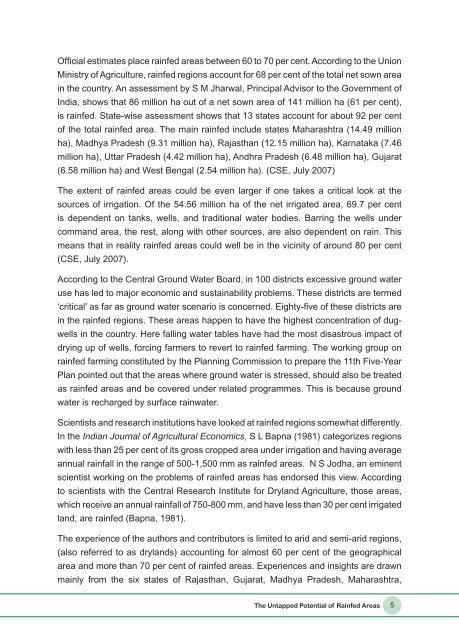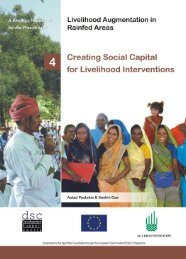Livelihood Augmentation in Rainfed Areas - Development Support ...
Livelihood Augmentation in Rainfed Areas - Development Support ...
Livelihood Augmentation in Rainfed Areas - Development Support ...
You also want an ePaper? Increase the reach of your titles
YUMPU automatically turns print PDFs into web optimized ePapers that Google loves.
Official estimates place ra<strong>in</strong>fed areas between 60 to 70 per cent. Accord<strong>in</strong>g to the Union<br />
M<strong>in</strong>istry of Agriculture, ra<strong>in</strong>fed regions account for 68 per cent of the total net sown area<br />
<strong>in</strong> the country. An assessment by S M Jharwal, Pr<strong>in</strong>cipal Advisor to the Government of<br />
India, shows that 86 million ha out of a net sown area of 141 million ha (61 per cent),<br />
is ra<strong>in</strong>fed. State-wise assessment shows that 13 states account for about 92 per cent<br />
of the total ra<strong>in</strong>fed area. The ma<strong>in</strong> ra<strong>in</strong>fed <strong>in</strong>clude states Maharashtra (14.49 million<br />
ha), Madhya Pradesh (9.31 million ha), Rajasthan (12.15 million ha), Karnataka (7.46<br />
million ha), Uttar Pradesh (4.42 million ha), Andhra Pradesh (6.48 million ha), Gujarat<br />
(6.58 million ha) and West Bengal (2.54 million ha). (CSE, July 2007)<br />
The extent of ra<strong>in</strong>fed areas could be even larger if one takes a critical look at the<br />
sources of irrigation. Of the 54.56 million ha of the net irrigated area, 69.7 per cent<br />
is dependent on tanks, wells, and traditional water bodies. Barr<strong>in</strong>g the wells under<br />
command area, the rest, along with other sources, are also dependent on ra<strong>in</strong>. This<br />
means that <strong>in</strong> reality ra<strong>in</strong>fed areas could well be <strong>in</strong> the vic<strong>in</strong>ity of around 80 per cent<br />
(CSE, July 2007).<br />
Accord<strong>in</strong>g to the Central Ground Water Board, <strong>in</strong> 100 districts excessive ground water<br />
use has led to major economic and susta<strong>in</strong>ability problems. These districts are termed<br />
‘critical’ as far as ground water scenario is concerned. Eighty-five of these districts are<br />
<strong>in</strong> the ra<strong>in</strong>fed regions. These areas happen to have the highest concentration of dugwells<br />
<strong>in</strong> the country. Here fall<strong>in</strong>g water tables have had the most disastrous impact of<br />
dry<strong>in</strong>g up of wells, forc<strong>in</strong>g farmers to revert to ra<strong>in</strong>fed farm<strong>in</strong>g. The work<strong>in</strong>g group on<br />
ra<strong>in</strong>fed farm<strong>in</strong>g constituted by the Plann<strong>in</strong>g Commission to prepare the 11th Five-Year<br />
Plan po<strong>in</strong>ted out that the areas where ground water is stressed, should also be treated<br />
as ra<strong>in</strong>fed areas and be covered under related programmes. This is because ground<br />
water is recharged by surface ra<strong>in</strong>water.<br />
Scientists and research <strong>in</strong>stitutions have looked at ra<strong>in</strong>fed regions somewhat differently.<br />
In the Indian Journal of Agricultural Economics, S L Bapna (1981) categorizes regions<br />
with less than 25 per cent of its gross cropped area under irrigation and hav<strong>in</strong>g average<br />
annual ra<strong>in</strong>fall <strong>in</strong> the range of 500-1,500 mm as ra<strong>in</strong>fed areas. N S Jodha, an em<strong>in</strong>ent<br />
scientist work<strong>in</strong>g on the problems of ra<strong>in</strong>fed areas has endorsed this view. Accord<strong>in</strong>g<br />
to scientists with the Central Research Institute for Dryland Agriculture, those areas,<br />
which receive an annual ra<strong>in</strong>fall of 750-800 mm, and have less than 30 per cent irrigated<br />
land, are ra<strong>in</strong>fed (Bapna, 1981).<br />
The experience of the authors and contributors is limited to arid and semi-arid regions,<br />
(also referred to as drylands) account<strong>in</strong>g for almost 60 per cent of the geographical<br />
area and more than 70 per cent of ra<strong>in</strong>fed areas. Experiences and <strong>in</strong>sights are drawn<br />
ma<strong>in</strong>ly from the six states of Rajasthan, Gujarat, Madhya Pradesh, Maharashtra,<br />
The Untapped Potential of Ra<strong>in</strong>fed <strong>Areas</strong><br />
5



